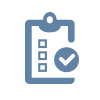FAQ
Questions about MAIA.tools
Allgemeine Fragen
The platform was designed for hospitals und private clinics, private care centres und doctors in private practice, die eine digitale Anamnese und Patientenaufklärung mit modernen digitalen Medien rechtsicher, effizient und patientenzentriert umsetzen wollen. Die Plattform wird für die Bedürfnisse der medizinischen Einrichtung und deren Patientinnen und Patienten spezifisch angepasst. Unsere Firma ist auf die Erstellung von Animationen und Filmen für Kliniken und medizinische Themen spezialisiert und arbeitet mit führenden Vertretern ihres Faches zusammen.
Für bestimmte Fachrichtungen bietet MAIA.tools ready-made educational packages including high-quality produced films and 3D animations. In particular, these are educational packages for frequent or treatments, such as endoscopic examinations (Colonoscopy, gastroscopy)
The acronym stands for Bring Your Own Device. We decided for this solution because it increases the return rate and reduces the burden on outpatient clinics, waiting rooms, and staff.
The MAIA platform is a web application that can be used from any browser-enabled device (PC, laptop, tablet and smartphone) without installation. Access is via SMS or email to the patient.
Yes, MAIA is a compact, self-contained system that can be located inside or outside the hospital's IT infrastructure and can exchange data with it. The data interfaces are adapted and customised for each customer.
Basically, information and its documentation involves a small amount of precise data that needs to be exchanged. Depending on the hospital's information system (HIS) or patient administration system (PVS), we adapt our output data and the interfaces used.
Working with patient data is an extremely sensitive area. For this reason, the MAIA platform is encrypted in many ways and fulfils the highest security requirements.
If the clarification or documentation of the clarification takes place on servers outside the clinic, all patient data on the platform is anonymous and is not linked to real names or a real patient profile or a digital patient file at any time during the ongoing clarification. Combining the data takes place after it has been fed back into the clinic's information system.
All our products are audited/auditable and are constantly tested for safety and functionality in accordance with the strictest legal requirements.
Yes. We offer our customers standard platforms that can be used immediately without any effort. Furthermore, we can fully customize the MAIA platform to match the corporate identity and corporate design of your company or practice/clinic on request.
Digitale Anamnese & Patientenaufklärung
Yes, security features and levels of automated documentation enable more detailed and complete documentation of the entire process of providing information and patient consent than is possible with handwritten notes on paper forms and information sheets. This multitude of data points, such as time stamps and the tracking of viewer interactions, can serve as additional evidence in terms of IT forensics for the information provided. Further information on this topic can be found at here..
According to the eIDAS Regulation, which applies in the member states of the European Union, i.e. also in Germany and Austria, a signature may not be denied validity in court simply because it is in electronic form. In practice, the forensic quality of the signature plays a role here. MAIA.tools implements appropriate solutions on a relatively individual basis and offers everything from simple signatures to signature solutions that meet the highest security requirements. As disputed signatures are relatively rare in the medical context and the signature is only one component of legal liability security, we recommend that our customers use "sign on glass" solutions (certain signature tablets), which represent an ideal balance between security and usability. However, it is foreseeable that with the introduction of qualified electronic signatures on electronic health insurance cards, electronic signatures with the highest levels of security will become commonplace. Further information on this topic can be found here..
"Not every patient has the same level of education. How do you make sure that every patient can understand all the information on the MAIA platform? It could be a doctor with a lot of medical knowledge or people who have never been to school." (Question from Heinrich Prokop)
MAIA creates visual summaries of complex medical information. Our films present complicated medical topics using clear images and simple language. The voiceovers in our videos ensure that all information is medically accurate and easy to understand. Compared to traditional written consent forms commonly used in clinics, our content is much easier to understand.
In our surveys, we noticed big differences in how patients answered questions about their operations. Patients who watched our films or got a mix of information did much better than those who only got a complicated text.
MAIA helps doctors tailor their responses to each patient's knowledge right after they finish the education module. In this way, patients' knowledge gaps can be recognized and addressed in a targeted manner during medial consultation.
The MAIA platform can be made available in any language.
This also goes for our digital content like animations and educational or informational films, which we provide to clinics, health centers, and medical practices. They are either recorded by native speakers or come with subtitles.
The reports for doctors, used for patient histories and explanations in foreign languages, are of course still available in German or English.
Language information may be requested in the digital medical history an can trigger a message to the practice. This can help to arrange an interpreter early if needed.
Only a small number of people today can't use digital media. Over half of those born before 1941 use the internet at least occasionally, and this number is expected to rise significantly, as most 70-year-olds are already using digital technology.
Nevertheless it is important to make digital info easy for older people to use and navigate, even if they're not tech-savvy. We also pay attention to the special requirements of visually impaired people, for example in the educational films for ophthalmological procedures. For this purpose we use enhanced contrasts or flat colouring.
For certain things, digital patient education for the elderly is even slightly ahead: for example, education in familiar surroundings, independent of time and place, which is also accompanied by the increased possibility of seeking help, is just as supportive as the particularly simple and lively transfer of knowledge through images/sound/text.
Nevertheless, there is a certain (decreasing) proportion of patients who cannot be reached via digital media at all. Thus MAIA integrates fallback strategies to prevent medical staff from having to deal with duplicate structures. You can find more information on the topic of digital education and ageing in this article.
A face to face dialogue between doctor and patient cannot (if only because of the legal requirements) and should not be replaced by digital patient information. However, we can replace paper medical history and information forms, manual documentation, redundant data maintenance and unnecessary duplicate structures.
We can improve patients' level of knowledge by casting complex medical issues in a simple and lively visual language and delivering them to patients in a timely manner. As a doctor, you will meet better-informed patients thanks to digital anamnesis and patient education, leaving your hands free for the really important questions and topics. This leaves more time for people.
PROMs, PREMs & Studien
Assessing quality of life and the success of treatment from the patient's perspective has become a high priority in medical care. PROMs (Patient Reported Outcome Measures) are now widely used in clinics in many disciplines, such as oncology and orthopaedics.
PROMs in electronic form (ePRO) are part of the standard package of digital informed consent with MAIA in the clinical area, but can also be implemented by us as part of a stand-alone solution.
With MAIA-ePRO, you can record the success of medical treatment from the patient's perspective efficiently and with virtually no additional effort by automatically sending out electronic patient questionnaires at certain intervals after treatment. The data is processed and can be used for topical areas as quality assurance or medical trials..
The great advantage of the solution with MAIA is that a treatment pathway already opened up by capturing medical history online continues to be used.This results in a logical process from the patient's perspective and increases the response rate.
Yes, this is usually possible without any problems and very quickly.
Usually, cross-indication PROMs (such as EORTC QLQ-C30 or FACT-G) and indication-specific PROMs (e.g. Fact-B for breast cancer) are combined.
As a service provider, we take care of the content and also request the corresponding licenses.
Yes, the MAIA platform is ideal tool for this. Medical studies, such as those carried out by university clinics, health authorities, pharmaceutical companies or quality management departments in hospitals in that regard.
Hierfür kann die MAIA-Plattform konsequent hinsichtlich der Studienvorgaben angepasst werden. Medizinische Voraufklärung (eConsent), zeitlich getaktete Fragebögen (z. B. PROM/ePRO) and decentralized data collection (EDC), even outside the clinic, as well as automatic data evaluation are the main features of the platform.The advantages over paper & Excel solutions are not only cost and time efficiency, but also the recruitment of study participants and improved data quality.
- As many as 86% of clinical trials fail to recruit required numbers of patients.
- Up to 86% of clinical trials do not reach recruitment targets within their specified time periods
- 27% of US investigators fail to enroll any patients at all.
- The leading cause of missed clinical study deadlines is patient recruitment, taking up to 30% of the clinical timeline.
Referenzen:
- https://www.nihr.ac.uk/about-us/how-we-are-managed/managing-centres/crn/key-statistics.htm
- https://linkinghub.elsevier.com/retrieve/pii/S1551-7144(17)30753-X
- https://www.linkedin.com/pulse/challenges-meeting-patient-recruitment-retention-goals-roehl
- https://www.sciencedirect.com/science/article/abs/pii/S0167629616000291
- https://www.clinerion.com/dam/jcr:3ef2af96-80be-4577-8fdb-d09611030d37/Clinerion-Patient_search_in_clinical_trials-Oemer_Seker-White_Paper-20160404.pdf
- https://www.forbes.com/sites/matthewherper/2017/10/16/the-cost-of-developing-drugs-is-insane-a-paper-that-argued-otherwise-was-insanely-bad/
- https://informaconnect.com/patient-recruitment-challenge-willie-muehlhausen-icon/
- https://www.clinicalleader.com/doc/getz-site-activations-hurt-by-commodity-mentality-0001
- D.L. Anderson, A Guide To Patient Recruitment, CenterWatch/Thomson Healthcare, Boston, Massachusetts, USA, 2001.
- Anonymous, Subject recruitment and retention: barriers to success, Editorial, Applied Clinical Trials Website, April 1, 2004 Available at http://www. appliedclinicaltrialsonline.com/subject-recruitment-and-retention-barriers-success Accessed October 18, 2017, Online post.
- S. Treweek, P. Lockhart, M. Pitkethly, J.A. Cook, M. Kjeldstrom, M. Johansen, et al., Methods to improve recruitment to randomised controlled trials: Cochrane systematic review and meta-analysis, BMJ Open 3 (2013), http://dx.doi.org/10.1136/ bmjopen-2012-002360 23396504.
ADVANTAGES OF OUR SOLUTION


Better education through animations and modern multimedia content

Questionnaires for anamnesis, PROMs, follow-up care or medical trials

Outsourcing of processes from clinic to patients' home
(just-in-time principle)

Data security through integration into clinic systems
